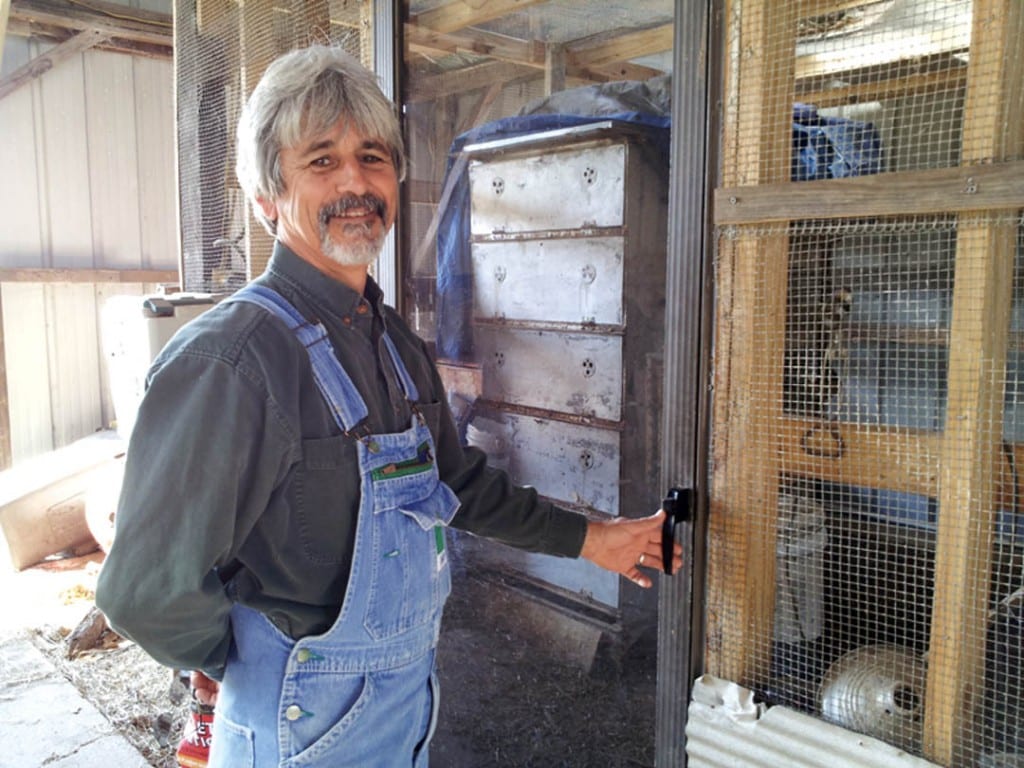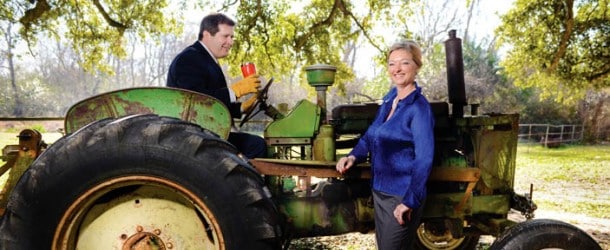Mini Farm Livin’ Is The Life For Kevin And Pam Mattingly And A Growing Number Of Other Locals
Kevin Mattingly and his wife, Pam, decided in 2007 to follow their dream of living in the country, growing their own produce, raising chickens, providing their own food, and living the peaceful and relaxing (though often strenuous) country life. The couple built a small home on 10 acres, purchased from Pam’s family (the land had been originally purchased by her great-grandfather in 1917), and, mimicking the plot of the old TV series Green Acres, eschewed city life for peace and quiet — and weeding, shoveling, tilling, mowing, harvesting and composting.
“If you see a nicely dressed man stopping his Chevrolet pickup on the side of the road to pick up bags of leaves, that may possibly be me, bringing that organic material back to my garden,” Mattingly quips.
Warren Hoag, Jr., and his wife, Martha, a local internist, have also embraced self-sustainable farming, growing their own produce — as well as chickens, turkeys, ducks and cows — and also keeping a few hives of honeybees — all on five acres.
Both families are part of a growing trend. For a variety of reasons, people are increasingly choosing to provide for themselves — and others — by growing their own produce, and raising their own food, even if they can’t afford, or don’t want to be responsible for, a large parcel of land — the 20- or 30-acre tracts of land one most often thinks of when thinking of farms and farmers.
“Ranchettes, three- to five-acre properties, are becoming very popular,” says Rocky Fontenot, owner of Rocky’s Feed and Garden Center in Sulphur. “More and more people are wanting to grow their own food, maybe raise some chickens. We’re having more and more people come in and ask about what to feed, say, chickens and cows, what to plant and when, and where to find livestock.”
Fontenot says the people who come to him for advice, equipment and feed for their new “mini-farms” are embarking on the endeavor for a variety of reasons.
“Some have inherited a small plot of land, and want to get into raising animals; some have kids who want to get into 4H and raise animals.”
Another large segment of the “back to the (mini) farm” movement? Retirees who are looking to return to the lifestyle they lived as a child, experience the quiet of the country after a hectic career and life in the city, or get in touch with nature.
Goodbye, City Life!
One of the main reasons for embracing gardening and farming on a small scale seems to be a simple desire to escape the noise and hectic pace of life in the city and reconnect with nature.
“It’s amazing how peaceful and quiet it is (at the farm),” Kevin says. “It’s funny how so many people have no connection to natural beauty simply because they haven’t had the opportunity to spend time outdoors.” He also says that working on his property and caring for the animals and garden is relaxing.
“It’s such stress relief, even just to mow the grass,” he says. “It’s so much fun.”
Just Plain Healthier
The other reason such farms, often called “urban farms,” are popular, is that, as people have become more health-conscious, they’ve begun questioning where their food comes from, and experiencing the difference between store-purchased food and food they raise themselves.
“Everyone wants to grow their own food,” says Fontenot. “They want to grow things like kale, spinach and broccoli — foods that are known to fight disease and promote health. And they want to eat food that they’ve grown themselves.”
“I just appreciate the healthiness of eating food we’ve grown ourselves,” says Mattingly. “If you’ve ever grown organic produce, you know it doesn’t stay fresh very long. And it makes you wonder just how supermarkets can keep produce fresh long enough to ship it to stores and let it sit on shelves for days.”

Warren Hoag explains the design of his chicken “brooder house,” where young chicks are hatched and raised.
The answer, he says, is additives and chemicals.The Hoag family began to, as Hoag says, “heal” their land, in order to live a healthier lifestyle.
The couple had always gardened, had fruit trees, and provided most of their own food — in fact, Hoag says he grew up “living off the land.” But his wife’s cancer diagnosis changed the way they operated the small farm, and radically changed the way they raised their food, and how and what they ate.
“We had a garden and used commercial fertilizers,” he says. “When my wife was diagnosed with cancer, she did a lot of research, and came home one day and said, ‘no red meat unless it’s pasture-based, and less processed foods’…”
It stands to reason, says Hoag, that a diet free of chemicals, pesticides and herbicides — and as natural as possible — is healthier.
For instance, some meats you purchase in the store are raised on steroids, he says.
“Steroids cause cell growth,” he says. “Cancer is rampant cell growth.”
Hoag says he isn’t an organic farmer … he goes beyond that. He raises his family’s food in as natural a way as possible.
“I try as much as possible to mimic nature,” he says. “Our cows aren’t fed corn — some cows that are labeled as organic are fed organic corn. Cows aren’t supposed to eat corn; they’re meant to eat grass.”

Hoag’s Compost Piles
The family eats as much unprocessed food as possible: whole grains, fruits and vegetables grown on the farm, and grass-fed meat and poultry.
The family also drinks raw milk, and keeps several beehives, from which the family gets raw, unfiltered honey.
The milk, says Hoag, has for him ended what had been a lifelong battle with irritable bowel syndrome and lactose intolerance (pasteurization, he says, kills important probiotics that help the digestive system); the honey, he says, has lessened his allergies to almost nil, by introducing enzymes and pollen into his system to boost immunity to pollen in the air — a benefit you won’t get from processed, filtered honey.
Eating from their farm, he says, also “forces you to eat seasonally. You’re not supposed to be eating tomatoes in winter unless you grew them locally and canned them,” he says, versus having tomatoes shipped in from who knows where and not knowing how they were grown. Living off the land, he adds, forces you to eat the fruits and vegetables you’re supposed to at the right time.
Making It Work
There’s a lot involved in raising animals and plants in a relatively small area, and the Mattinglys say they’re still very much in the learning stage, though they have learned many tricks, such as planting certain plants close together in order to reduce pests and promote growth. Pam also, she says, gardens in small plots rather than one large garden, making weeding and other garden work easier.
Hoag is an old hand, and he’s developed a system that seems to work perfectly for the acreage he has. He says the key is mobility. In keeping with his “mimic nature” philosophy, Hoag’s animals are always moved around on the property.
“Think about it — in nature, everything moves,” he says. “Animals don’t stay in one place; they don’t stay in their own waste day in and day out; they don’t stay on a piece of ground they’ve overgrazed.”
Hoag’s chickens and rabbits are kept in mobile houses — his laying house, which he calls the “eggmobile,” is on wheels; his rabbit cages have cables attached for easy moving.
The chicken coops are rotated around the garden to fertilize it. And the cows are rotated on the property daily. The steady rotation helps keep the grass healthy, and keeps the parasites and pests down to almost nil.
Hoag’s cow pasture is enclosed by a solar-powered electric fence; a series of insulated posts and an electrical wire, connected to each side of the fence, allows him to “segment” the pasture. Cows are allowed to graze and manure a segment each day; at the end of the day, the wire is moved, and the cows are confined to a different part, or segment, of the pasture. This keeps the cows from having to stand in their own manure, and keeps them from overgrazing the pasture.
Three days after the cows have left a certain segment of the pasture, the chickens are allowed to roam the segment, spreading the cow manure and eating parasite larvae. This, along with the fact that the cattle are never on the same piece of land for 30 days (the normal parasite cycle is 21 days) means that Hoag doesn’t have to worry about worming his cattle. He also doesn’t have to worry about spraying the cattle for flies, as the chickens also take care of any fly larvae in the pasture.
The rotation of the cows and chickens on any one segment of pasture is followed by goats and other animals, each of whom fertilize the grass, and eat different plants, meaning that weeds aren’t a problem.
It’s a system that works in harmony to create as natural and self-sustaining environment as possible.
But Hoag doesn’t shun modern technology entirely. Aside from the solar panels powering his fence, he also owns an electric “plucking machine” that can pluck a chicken in, literally, seconds. He also has a stainless steel honey extractor.
Hoag also composts extensively, putting as much as possible back into the earth, which results in top-quality, healthy soil.
The family uses nearly everything harvested on the farm. The day I visited, Hoag had at least two dozen pint jars of homemade canned chicken stock he’d made the night before from the carcasses of the chickens he’d butchered the day before.
A Better Way Of Life
It’s a lot of work, but it’s a peaceful, healthy lifestyle that’s becoming increasingly attractive to those who want not only a less hectic lifestyle, but also want to know where and how the food they eat was raised and prepared.
“Food just seems to taste better knowing that I grew it, and I enjoy it so much more when I know where it came from,” says Hoag.
To Get Started
Interested in finding out more about growing your own food? Visit the website of the Southern Sustainable Agriculture Working Group, which gives you access to webinars, and info on future conferences. And Rocky’s always glad to help with advice, brochures and suggestions on where to find further information.
Kevin and Pam Mattingly are also planning to host a “mini farming conference” on or about April 11, featuring speakers who will discuss such areas as pigs, goats, chickens and beekeeping. Lagniappe will have the details in a future issue.



















Comments are closed.